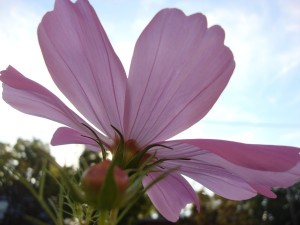 Summary. This document provides, in simple terms, an explanation of how to use manual camera settings for better photography results with pocket cameras or larger DSLR cameras. Click the photos on this page to enlarge them.
Summary. This document provides, in simple terms, an explanation of how to use manual camera settings for better photography results with pocket cameras or larger DSLR cameras. Click the photos on this page to enlarge them.
Automatic Mode. When a camera is in automatic mode, it makes many assumptions about your intended photo composition and the conditions. The camera makes an assessment of available light and arrives at an average, then sets the ISO, shutter speed, and aperture accordingly (using a flash if necessary). Yet ultimately, the camera can’t read your mind and doesn’t know for sure what the subject of your photo is. Here are the challenges a camera faces when trying to configure the settings:
- Motion. The camera doesn’t know if you and or the subject of your photo are moving or not. The default settings typically assume little or no motion.
- Focal Point. The camera doesn’t know what object in the photo is to be in focus as the subject of your photo.
- Focal Depth. The camera doesn’t know if you intend for only one object to be in focus or if you would like close and distant objects in focus.
- Lighting. The camera knows the general lighting and can arrive at an average cumulative light. However, complex photos may contain a wide range of bright and dark objects. The camera doesn’t know if it should adjust light for the darkest object, lightest object, or something in between. Additionally, in low light conditions, the camera doesn’t know if you want a fully illuminated photo, or if you are trying to have the resulting photo be an authentic representation of the low light conditions.
Given the wide variety of possible conditions and photo composition options described above, it’s surprising that a camera in automatic mode can produce a satisfactory photo. To accomplish this, the default camera settings are such that photos taken in automatic mode will be adequate for typical photos that people are taking. Newer cameras are able to recognize faces and detects smiles to ensure that portrait photos are optimal.
Manual Settings. It’s difficult to manually improve on what most cameras are able to do automatically in a split second. However, in some circumstances, manual control of camera settings can be necessary. Below are examples of difficult conditions and what manual settings were used to improve on what the automatic default settings would have produced.
Focal Depth
 Sometimes it’s nice to have a very defined focal depth. This brings your subject into sharp focus but leaves everything else out of focus. It’s a technique often used for closeup pictures of flowers. The photo to the right of a palm tree is an example of this.
Sometimes it’s nice to have a very defined focal depth. This brings your subject into sharp focus but leaves everything else out of focus. It’s a technique often used for closeup pictures of flowers. The photo to the right of a palm tree is an example of this.
The automatic focus in a camera tries to figure out the subject of your photo and focus on that. To do so, it assumes the subject of your photo is in the middle. However, in more creative photos, your subject might not be in the middle of the photo.
One technique in automatic mode is to point at your subject, push the shutter button half way as if you are about to take a picture (this will cause the camera to focus on your subject and set lighting accordingly), then frame the shot and push the button the rest of the way. Alternatively, in manual mode, you can manually focus until your subject is sharp and everything else is blurry. Below are three photos that illustrate focal point and focal depth. Setting the focal point ensures your subject will be in focus (like focusing on the palm tree above). The settings used for the photo above were as follows.
 Photographer Gregory Johnson explains, “While visiting an Ashram in India, I took a series of three photos showing a palm tree, a white wall, and some buildings in the distance to show various focal points and varied focal depth. One picture has the tree in focus, another has the wall in focus, and in another the tree, the wall, and buildings in the distance are in focus. In the pictures with a narrow depth of focus, I set the aperture to f/4.5 which allowed for an abundance of light, so I could use a very fast shutter speed of 1/2000th of a second. My goal was a really crisp clear picture.”
Photographer Gregory Johnson explains, “While visiting an Ashram in India, I took a series of three photos showing a palm tree, a white wall, and some buildings in the distance to show various focal points and varied focal depth. One picture has the tree in focus, another has the wall in focus, and in another the tree, the wall, and buildings in the distance are in focus. In the pictures with a narrow depth of focus, I set the aperture to f/4.5 which allowed for an abundance of light, so I could use a very fast shutter speed of 1/2000th of a second. My goal was a really crisp clear picture.”
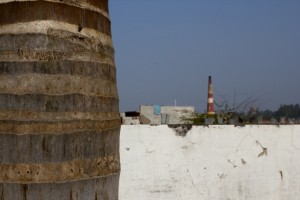 The focal depth is determined by the aperture (how big the lens shutter opening is when you snap the picture).
The focal depth is determined by the aperture (how big the lens shutter opening is when you snap the picture).
If the lens opening is large (a low number) then only your subject will be in focus, as seen in the example above where an aperture of f/4.5 was used resulting in only the palm tree being in focus.
If the lens opening is small (a higher number) then the foreground and background will be more in focus as well, as seen in the example to the right showing a palm tree in the foreground that is in focus as well as a wall behind it and buildings in the distance. The settings used to produce the photo to the right were as follows.
 Photographer Gregory Johnson explains, “In my series of palm tree photos, I concluded with a final picture showing everything in focus. As I recall, I put the camera into AV (aperture variable) mode and set the aperture to f/29 to achieve the greater focal depth. I had to stand fairly still for this photo because the smaller shutter opening would let only a little light in and required a shutter speed of 1/60th of a second. This is an example of where a tripod would have been helpful, because I could have really tightened up the shutter opening to a very small hole and let the lens stay open for a longer period of time. Another option would have been to boost the ISO from 125 to something like 1000 or 1600. However, I was really liking this photo, and shooting in RAW, so I wanted to do everything possible to retain the clarity. A higher ISO would have been noisy (grainy or fuzzy).”
Photographer Gregory Johnson explains, “In my series of palm tree photos, I concluded with a final picture showing everything in focus. As I recall, I put the camera into AV (aperture variable) mode and set the aperture to f/29 to achieve the greater focal depth. I had to stand fairly still for this photo because the smaller shutter opening would let only a little light in and required a shutter speed of 1/60th of a second. This is an example of where a tripod would have been helpful, because I could have really tightened up the shutter opening to a very small hole and let the lens stay open for a longer period of time. Another option would have been to boost the ISO from 125 to something like 1000 or 1600. However, I was really liking this photo, and shooting in RAW, so I wanted to do everything possible to retain the clarity. A higher ISO would have been noisy (grainy or fuzzy).”
There are many benefits to choosing a shallow depth of field by having a large aperture (shutter opening). This setting lets more light into the camera, so the following benefits are gained:
- You can use a lower ISO for sharper pictures.
- You can use a faster shutter speed which ensures your own movement won’t result in a blurry photo.
- A flash is likely not necessary since more light is getting into the camera through the lens.
- When the image is compressed, the compression process has less unnecessary detail to worry about. The subject can be very crisp and less degraded by the compression process, while the background and irrelevant foreground can be easily compressed since they are blurry anyway. They are pre-optimized for efficient compression. So, more information can be retained for what’s important.
Low Light With Motion
 The following combination of conditions create a difficult photo to shoot: low light, no flash, a moving subject, and the desire to freeze the image with no motion blur. In fact, it would be almost impossible to create a high quality photo in these conditions.
The following combination of conditions create a difficult photo to shoot: low light, no flash, a moving subject, and the desire to freeze the image with no motion blur. In fact, it would be almost impossible to create a high quality photo in these conditions.
The picture shown to the right of water dripping from a faucet into a bucket is an example of the conditions described above. To capture this photo, the following settings were used.

Photographer Gregory Johnson explains, “In the photo of water dripping from a faucet into a bucket, I had to boost the ISO to 6400, resulting in high light sensitivity, in order to use the very fast shutter speed of 1/1000th of a second. With my lens set at 18mm and the aperture set to f/3.5 there was the maximum amount of light coming in. The resulting photo gave me the general content that I wanted, but I did notice considerable noise (fuzziness) in the picture because of the high ISO. I used the noise removal feature in my software to clean up the picture and was left with something I really liked. With the noise removed, it looks like it was taken using a much lower ISO.”
Motion Fluid Blur Photos
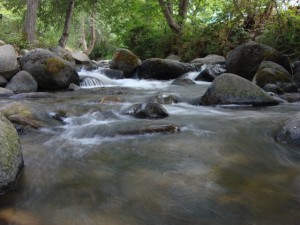 Sometimes it’s nice to convey motion in a photo by showing the blur of movement. The photo to the right from 16 July 2008 shows water in a stream at a park in Ashland, California.
Sometimes it’s nice to convey motion in a photo by showing the blur of movement. The photo to the right from 16 July 2008 shows water in a stream at a park in Ashland, California.
The settings used to create this photo are as follows.

Photographer Gregory Johnson explains, “In this photo I wanted to show the soft blur of moving water. I’d seen this is glossy photos that almost look as if they are painted. I knew I needed to slow down the shutter speed, but I wasn’t sure what setting to use. I tried 1/40th of a second, but that was too fast. Eventually I realized that 1/2 a second was needed. Leaving the shutter open for a half a second would require that the camera be completely still, so I set it on a rock. I was really pleased with how this photo came out because the rocks and trees are crisp and sharp, but the water has that soft blur that I wanted. I was using the Sony DSC-N2 camera with 10 megapixel capacity.”
Motion Still Photos
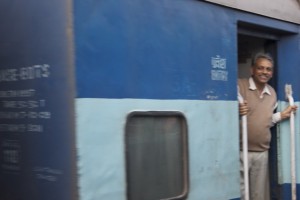 For most cameras, the automatic mode will assume that you and your subject are relatively motionless. Some cameras have image stabilization to compensate for some movement by the photographer, but cameras typically don’t detect movement of the subject. For this reason, taking a photo from a car or train generally results in a blurry photo, especially of objects that are close.
For most cameras, the automatic mode will assume that you and your subject are relatively motionless. Some cameras have image stabilization to compensate for some movement by the photographer, but cameras typically don’t detect movement of the subject. For this reason, taking a photo from a car or train generally results in a blurry photo, especially of objects that are close.
With the picture shown to the right, both the photographer and the subject were in motion on trains traveling very fast in opposite directions. Taking the photo using automatic settings would have produced a blue blur. So, the following manual settings were used.
 Photographer Gregory Johnson explains, “I was riding on a train in India taking pictures out the door. Another train came along going in the opposite direction. To the naked eye, it was just a blur. I wondered what might happen if I increased the shutter speed a bit to freeze the motion of the train. Afterwards, I was surprised to discover this photo of a man smiling as if posing for the camera. As I recall, for this picture, I chose the TV mode (time variable) and selected the faster shutter speed, then let the camera choose the necessary aperture and ISO. If I set the shutter speed too high, the camera would have chosen a higher ISO and that might have produced a noisy (grainy or fuzzy) image. So, I went with the 1/640th of a second shutter speed. My camera has an automatic mode for sports photography. That might have achieved similar results.”
Photographer Gregory Johnson explains, “I was riding on a train in India taking pictures out the door. Another train came along going in the opposite direction. To the naked eye, it was just a blur. I wondered what might happen if I increased the shutter speed a bit to freeze the motion of the train. Afterwards, I was surprised to discover this photo of a man smiling as if posing for the camera. As I recall, for this picture, I chose the TV mode (time variable) and selected the faster shutter speed, then let the camera choose the necessary aperture and ISO. If I set the shutter speed too high, the camera would have chosen a higher ISO and that might have produced a noisy (grainy or fuzzy) image. So, I went with the 1/640th of a second shutter speed. My camera has an automatic mode for sports photography. That might have achieved similar results.”
Zoo Photos
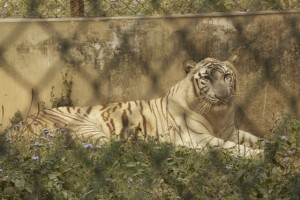 Photos taken at a zoo present some unique challenges. Although we’re sometimes given an opportunity to get close to animals, usually they are at a distance, and often in cages, behind fences or glass.
Photos taken at a zoo present some unique challenges. Although we’re sometimes given an opportunity to get close to animals, usually they are at a distance, and often in cages, behind fences or glass.
These obstacles can obscure the photo, as seen in the photo to the right of a white tiger with a fence in the foreground (click image for larger view).
Zoos typically have an abundance of greenery and trees to reproduce the natural surroundings and habitat that various animals are accustom to. This often results in reduced lighting.
For animals at a distance, a telephoto zoom lens can be used. However, zoom lenses need more light and they increase the chances of blurred pictures caused by motion unless higher shutter speeds and/or a tripod are used.
The following camera settings were used for the photo above of the white tiger behind a fence.
 Photographer Gregory Johnson explains, “When I arrived at the zoo in Lucknow, India, I quickly switched from my 18-55mm lens to my 55-250mm zoom lens, anticipating that most of my pictures would require a telephoto lens. In this example, I was using the manual focus since the automatic focus would have focused on the fence rather than the tiger. Even so, having the aperture set to f/13 resulted in the fence being visible as well as the tiger. I took this photo to illustrate the challenge that I was faced with while at the zoo. If you look at my gallery of pictures from the Lucknow Zoo, you’ll find that most of them are relatively clear pictures of animals with no fences showing. In one photo of a bird, there was a fairly dense mesh fence between me and the bird, yet it didn’t show up at all. So, here’s the trick I used to remove the fences.
Photographer Gregory Johnson explains, “When I arrived at the zoo in Lucknow, India, I quickly switched from my 18-55mm lens to my 55-250mm zoom lens, anticipating that most of my pictures would require a telephoto lens. In this example, I was using the manual focus since the automatic focus would have focused on the fence rather than the tiger. Even so, having the aperture set to f/13 resulted in the fence being visible as well as the tiger. I took this photo to illustrate the challenge that I was faced with while at the zoo. If you look at my gallery of pictures from the Lucknow Zoo, you’ll find that most of them are relatively clear pictures of animals with no fences showing. In one photo of a bird, there was a fairly dense mesh fence between me and the bird, yet it didn’t show up at all. So, here’s the trick I used to remove the fences.
 In the photo of the white tiger shown to the right, you’ll notice that the fence is barely visible (click for larger view). To create this effect, I simply reduced the aperture to f/5.6 to reduce the focal depth.”
In the photo of the white tiger shown to the right, you’ll notice that the fence is barely visible (click for larger view). To create this effect, I simply reduced the aperture to f/5.6 to reduce the focal depth.”
The settings for this photo were as follows.

“The larger lens opening of f/5.6 let more light in and allowed me to reduce the ISO to 200 and still maintain a relatively fast shutter speed of 1/250th of a second. The lower ISO should result in a sharper image. This effect works better when the subject of your photo is a considerable distance away.”